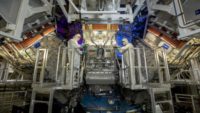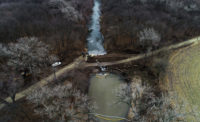The relics of America’s World War II and Cold War past spread across 580 sq miles of desert plateau in southeastern Washington state in the form of decaying buildings and massive waste storage tanks that sustained plutonium production from 1943 to 1987.
For more than three decades at the massive Hanford site near Richland, Wash., the U.S. Energy Dept. has tasked employees and multiple contractors to assess and clean up the daunting environmental legacy of making the nation's nuclear weapons. Billions of dollars have been spent, but billions more are needed.
The task may not get done for decades—if ever—with current technical knowhow and budgets.
Now, a core piece of the cleanup program nears a milestone after 17 years and $17 billion of construction: startup of the first phase of a new production complex to transform a chunk of Hanford’s 56 million gallons of long-stored radioactive waste into inert glass for safe disposal and future decay.
Nearly 3,000 on-site employees are attached to Hanford's Tank Waste Treatment and Immobilization Plant, dubbed Vit Plant, including 1,500 trades workers. But as it pushes to meet court-imposed mandates, the project and its innovative technology still face big technical and funding uncertainties and stakeholder skepticism.
“We are really at a stage we have never been at before. People can see the end is in sight.”
– Valerie McCain, Bechtel principal, vice president and Vit Plant project director.
The project was conceived two decades ago to pump the radioactive waste from 177 aging underground tanks, about 60 of which have leaked to the subsurface and likely into groundwater.
Using vitrification technology, the pumped waste will be heated to 2,100° F and blended with glass-forming materials. The molten mixture then will be poured into stainless steel canisters to cool and solidify, protecting humans and the environment from radioactivity as it dissipates over hundreds to thousands of years.
The technology has worked elsewhere—in France, Japan, Russia and the U.K., and has been used to treat 40 million gallons of waste at DOE’s Savannah River site in South Carolina—but never at Hanford's scale, nor to process the site's complex waste mix that includes up to 1,800 other hazardous chemicals.
“One of the last major challenges left, if not the last major challenge left, is to get the waste out of those tanks and turned into stable forms where we will store the waste,” says Erik Olds, DOE deputy project integration manager at Hanford.
The plant’s plan and construction has been led since 2000 by Bechtel National Inc. The work spans 65 acres and includes four major components: a 12-story pretreatment facility to separate waste streams for treatment by radioactivity level; a smaller plant to vitrify low-activity wastes—those with small amounts of radionuclides; a six-story structure measuring 440 ft by 275 ft to treat high-level waste streams; and an analytical laboratory.
In all, Bechtel is now designing, constructing and commissioning the world’s largest radioactive waste treatment plant.
Moving Target
But the project—based on a design in a 1997 environmental impact statement—has been plagued by technical challenges and delays, and its cost now is about four times its original projection.
Project and government managers and regulators sparred regularly over scope changes, and progress and cost impacts that affected Bechtel performance incentives, most recently for 2018, says an April report in Tri-Cities-Herald, the regional newspaper that has followed the Vit Plant closely since its start. The newspaper notes improvements this year.
Even so, the current project price tag remains a moving target more than a decade from full completion,
Years and billions of dollars beyond the original scope, DOE has tamped down expectations as safety and quality assurance issues emerged in the high-level waste (HLW) treatment process, some raised by whistleblowers, including one whose alarms resulted in his firing by site subcontractor URS, now part of AECOM, and a subsequent $4-million wrongful termination judgement.
Originally intending to treat all waste in a single stream, DOE in 2013 moved to create what is now called the Direct-Feed Low-Activity Waste (DFLAW) process, which will allow treatment of what the agency says is 90% of tank waste, which is considered "low-activity", through a designated vitrification plant as engineers work out technical and design issues for high-level waste treatment.
Last month, Brian Vance, who heads DOE operations at Hanford, told the Washington state Dept. of Ecology in a “notice of serious risk” that his agency “cannot project with certainty” when the high-level waste or pretreatment plants will be completed.
The state has some legal oversight over cleanup activity, based on a 1989 consent decree. A 2016 follow-on agreement mandates Bechtel to demonstrate the ability of both facilities to work with radioactive waste by 2033 and reach full operation by 2036.
“We’re still reviewing the notice and its implications,” said a state agency spokesman. The state has been in more frequent talks with DOE since spring, when its top environmental official asked for a “frank discussion” of project challenges.
With a new process configured to separate waste streams, DOE said in a statement it “remains firmly committed to, and is on schedule to meet” a December 2023 target to treat low-activity waste.
Even so, a congressionally mandated National Academies of Science draft report issued in mid-September raises concerns about the plant’s ability to treat the large amount of site low-level waste in time to meet the deadlines, based on existing design.
The draft study noted options such as expanding the plant, which could push its cost to $20 billion or higher, or cheaper treatments such as grouting or fluidized-bed steam reforming that would turn waste into a ceramic-like material.
But it cautions that because the approaches have not been fully developed or tested, the “large attendant uncertainties” mean costs could be much higher.
DOE and the state announced last month a new round of talks starting in November on cleanup strategies and deadlines, possibly using a professional mediator, that will continue until next summer.
|
Read Update on Another Federal Megaproject |
End in Sight
While construction on the Vit Plant high-level and pretreatment facilities has stopped since 2012 as process question marks remain, DOE is, for the first time, “laser-focused” on DFLAW process startup by 2023, Vance told attendees of a DOE cleanup workshop in September, according to industry publication Weapons Complex Monitor. “Once you turn it on, you operate 24/7, 365,” he said.
Valerie McCain, Bechtel principal vice president and Vit Plant project director told ENR: “We are really at a stage we have never been at before. People can see the end is in sight.”
That still may be a tough concept, with cleanup dates stretching to the end of the century for the entire 580-sq-mile Hanford site and tuture costs ranging from $323 billion to $677 billion, based on changing estimates, and annual federal spending of about $2.5 billion. About $690 million of that money goes to the Vit Plant’s DFLAW project each year.
But Olds, who now manages DFLAW, says uncertainty in annual funding strains progress.
The House of Representatives fiscal 2020 spending bill restores about $381 million to the overall Hanford site cleanup budget cut out of the Trump administration budget proposal, but it still is $37 million less than fiscal 2019 funding. The Senate spending bill, still in committee, proposes more than the House total.
Rep. Dan Newhouse (R), who serves the district that includes Hanford and helped push up funding, says he constantly monitors the project and is confident in the DFLAW initiative. “The federal government has a legal and moral obligation to complete the cleanup, and we must ensure the significant resources going toward the effort,” he says.

Waste in Hanford’s single- and double-shell tanks must be pumped to treatment facilities.
GRAPHIC COURTESY DOE
Delivering Infrastructure
Construction is showing progress in terms of connecting the key plants, along with supporting facilities and systems, plus a large amount of interlocking piping, electrical and utilities infrastructure.
Nearly 36% of total DFLAW systems—64 of 180—have successfully completed startup and testing and are being commissioned. Another 51% (92 systems) are in startup, and the final 13% (24 systems) are nearing construction turnover to startup. “It was a transformational year for us,” McCain says.
The next major project milestone, the “loss of power test,” is a critical activity needed to start the facility’s two vitrification melters. Once the melters reach operating temperature, they can never shut down.
The 28-day test to determine that the plant has adequate backup power in an emergency situation is set for late 2020, ahead of the 2021 commissioning deadline and glass manufacturing in 2022. The Vit Plant control room already operates 24/7, and analytical lab staff work off site with the same equipment and procedures that will be used on site next year.
Olds says about 11 million gallons of waste are set to be pumped to the facility. “To have actual discussions about operations … on site is a great place to be,” he says.
“The federal government has a legal and moral obligation to complete the cleanup, and we must ensure the significant resources going toward the effort.”
– Rep. Dan Newhouse (R-Wash)
Hanford’s tank farm, run by AECOM-led Washington River Protection Solutions, stages the waste and will deliver it to a separation process tank.
Engineering to send waste from one part of the site to another posed challenges, says Rick Holmes, general manager for Waste Treatment Completion Co., a joint venture of Bechtel and AECOM. Once waste moves into the Vit Plant purview, managed by Bechtel, it will be analyzed and processed into vitrified glass.
Holmes says one hurdle in the turnover and handover phase is ensuring that equipment, some installed in 2002, meets current protocol standards. This process, he says, requires extensive testing and, at times, process alterations.
The final step will require transporting the glassified waste to a 1-million-cu-meter, $25-million on-site disposal facility operated by Hanford contractor CH2M Plateau Remediation Ltd.
Creation of the DFLAW approach required adding both a new effluent management facility and the low-activity waste (LAW) facility.
The former will handle secondary waste liquid generated in treatment, and the latter is a 330-ft-long, 240-ft-wide and 90-ft-high concrete structure designed to mix waste with silica and other glass-forming materials before it reaches the two 300-ton melters.
At about 20 ft by 30 ft and 16 ft tall, the world’s largest waste glass melters will create vitrified glass resting in containers 7 ft long and 4 ft in diameter, weighing more than 7 tons each.
During plant operations, the two melters will produce 30 tons of glass daily, 10 times the capacity of the melter in operation at DOE’s Savannah River Site.
Holmes says a mixture recipe is generated for each waste batch by the lab in conjunction with DOE and Pacific Northwest National Laboratory experts. “Nothing I have ever done has prepared me for this,” Holmes says. “The scale is a pretty significant leap.
With melters designed for an annual throughput of about 1.75 million to 2 million gallons of tank waste per year, each has a five-year operating life. A third melter will be on site before treatment begins. DFLAW has a 40-year design life.
DOE says that previous outstanding technical and design questions on the DFLAW process have been answered and cleared by the state.
But the high-level waste process, by contrast, remains in design and it is unclear how or whether its facilities will be finished. While nine main technical issues raised on the pretreatment structure have been resolved, the last two in August, “I would be jumping ahead to give you a conclusion,” Olds says.
Compounding uncertainty, DOE proposed guidelines in June to reclassify some high-level waste as low-level—a move Hanford watchdog groups adamantly oppose and Washington Gov. Jay Inslee (D) termed “reckless.”
While supported by some local groups to speed cleanup and Hanford redevelopment, the reclassification was banned in language added to the House-passed spending bill.
DOE officials at Hanford have said that they have not committed to any reclassification change.
A U.S. Army Corps of Engineers analysis of options and budget scenarios to enable reaching key consent decree milestones for the HLW and pretreatment plants indicates there is a “low probability” it can do so “under the current funding profile,” says DOE.
To meet this challenge, the agency has contracted with an independent firm to develop alternatives by late 2019 for future decisions.
Future Doubts
Tom Carpenter, executive director of leading site watchdog group Hanford Challenge, says no part of the Vit Plant should operate short of a complete and independent inspection that validates and verifies nuclear treatment quality.
“I seriously doubt the High-Level Waste facility will ever operate for numerous reasons, and DOE will simply find that the waste is low-level, not high-level, dump concrete on the whole mess and call it good.”
– Tom Carpenter, executive director, Hanford Challenge
“DOE seems to be doing everything in its power to simply walk away from its legal and moral obligations to deal with Hanford’s extraordinary radioactive waste inventories,” he contends, related to the proposed waste reclassification.
“I seriously doubt the HLW facility will ever operate for numerous reasons, and DOE will simply find that the waste is low-level, not high-level, dump concrete on the whole mess and call it good.”
While Carpenter supports vitrifying tank waste, he has concerns with what he calls consistent design flaws, a lack of quality control and a “poor nuclear safety culture” at the site.
Carpenter cites whistleblower lawsuits and reassignment of employees who raised safety concerns.
For DOE and Bechtel, the focus remains on the 90% of waste they say they can successfully treat via the DFLAW process.
“There have been quality issues in the past that slowed things, but those have been addressed,” McCain says. “Having legacy issues behind us was a big burden off the project.”
David Reeploeg, vice president of federal programs for local economic development group TRIDEC, is encouraged with progress made in recent years, but says funding remains the “single biggest challenge.”
Not only does the project need hundreds of millions of dollars every year to meet milestones and agreements, he says it will be “critically important for DOE and its regulators to identify ways to reduce the long-term cost and schedule for Hanford cleanup,” something that the Vit Plant’s history has already shown won’t be an easy task.

















Post a comment to this article
Report Abusive Comment